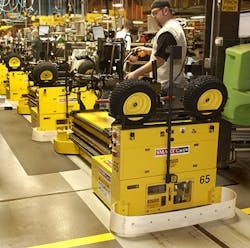Europe Extends the Transition to EN ISO 13849-1
On December 29, 2009—the same date that the new Machinery Directive 2006/42/EC became the governing document for safety and supply of machinery across the European Economic Area (EEA)—machine and component builders were given a little break in the wake of this change: the transition period for moving from EN 954-1 to EN ISO 13849-1 was extended to December 31, 2011.
Accepted as a European Standard in 2006, EN ISO 13849-1 was published as the standard to replace EN 954-1. Since May 2007, EN/ISO 13849-1 (“Safety of machinery – Safety-related parts of control systems – Part 1. General principles for design.”) has been harmonized under the EU Machinery Directive as the successor to EN 954-1. Before the recent extension, it was to have obviated EN 954-1 on November 30, 2009.
Because EN ISO 13849-1 addresses deficiencies inherent in the EN 954-1 and accommodates new technology now commonly used in safety systems and components, major manufacturers are expected to continue preparing for and moving to the new standard.
“It’s fair to say that a manufacturer choosing to use 13849-1 instead of 954-1 will increase customer confidence in the safety and integrity of his product,” says Kevin Connelly, business development manager at Underwriters Laboratories (UL). It is also fair to say that products compliant with EN ISO 13849-1 will have greater resonance in both current and emerging markets.
Where Things Stand
As a general rule, EN 954-1 can continue to be used to claim conformity with the Machinery Directive until the end of 2011. However, if a Type C standard can be applied (these standards deal with specific types of machines) and it refers to EN ISO 13849-1, then the presumption of conformity for 954-1 is no longer valid. If a Type C standard still references EN 954-1, then EN 954-1 or EN ISO 13849-1 may be used. If no appropriate Type C standard exists, any appropriate harmonized standard (i.e., EN ISO 13849-1, EN62061, EN 954-1) may be used to design a safety-related control system.
Why EN ISO 13849-1?
Unlike EN 954-1, EN ISO 13849-1 addresses the programmable electronic safety devices that are being used increasingly in modern machines. “The standard also provides a quantitative approach to risk assessment and safety validation,” adds Thomas Maier, principal engineer, functional safety, at Underwriters Laboratories. Under this standard, the risk assessment for a given safety function will yield a Performance Level (PL), a new concept of measuring safety. According to Maier, PLs quantify the required and achieved level of safety in probabilistic terms,. The “good old categories” of 954-1 still exist, as another parameter of a Performance Level, and measures for diagnostic capability and common cause failures are defined. This makes sure that safety is not solely a matter of component reliability, but also relies on common-sense safety principles such as redundancy, diversity, and fail-safe behavior.
“The bottom line is increased confidence that the required level of safety, as yielded by risk assessment, is accurate,” says Maier. “This helps eliminate both over- and under-engineering, a costly or risky result of 954-1’s shortcomings.”
In addition to providing a quantitative approach to risk assessment and safety validation, EN ISO 13849-1 considers software as a safety-related part of a control system. “To avoid the introduction of faults in software, EN ISO 13849-1 requires that a V model-based approach is taken for software development,” says Maier. (The V model approach is common good practice in the development of software and complex systems. On the left side of the “V” is the development path; on the right side is the verification path. For every step of development, corresponding verification or validation must take place.) According to ISO 13849-1, the main objective is to have readable, understandable, testable, and maintainable software.
Additionally, the standard differentiates between safety-related embedded software (SRESW) and safety-related application software (SRASW). SRESW is what typically needs to be developed by safety component manufacturers, and will almost always be written in so-called “Full Variability Languages” (FVL), HW-near languages such as C or Assembler.
SRASW is typically developed by the machine builder, integrating industrial components for the sensor, logic, and actuator parts of a safety-related system. SRASW is often developed using “Limited Variability Languages” (LVL) such as function block or ladder diagrams.
How To Facilitate the Process
“Consolidating product testing and certification at one global organization creates significant efficiencies that can deliver greater return on your compliance investment,” says Connelly. “This certainly holds true for compliance with this new standard.”
In fact, UL can provide type examination reports for an abundance of machinery standards, including but not limited to EN ISO 13849-1, IEC 61508, and IEC 62061. “If you’re submitting new product for certifications or looking to add certifications to existing product, you should talk to us about how we can facilitate your process and get your product to market faster,” concludes Connelly.
For more information on EN ISO 13849-1 or other harmonized standards for the new Machinery Directive, please contact:
Kevin Connelly
631-546-2691
[email protected]
Or go to www.ul.com/functionalsafety.

